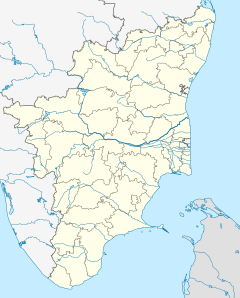
Sivakasi is a city in Virudhunagar District in the Indian state of Tamil Nadu. The city is known for firecrackers and match factories that produce 70% of the country's produce. The printing industries in Sivakasi produce 30% of the total diaries produced in India. The industries in Sivakasi employ over 25,000 people and the estimated turnover of the firecracker, match making and printing industries in the city is around ₹20 billion (US$240 million). The major issues in the city are the frequent accidents in the firecracker factories and the high level of child labour.

The Nellaiappar Temple is a Hindu temple dedicated to the deity Shiva, located in Tirunelveli, a city in the South Indian state of Tamil Nadu. Shiva is worshipped as Nellaiappar represented by the lingam and his consort Parvati is depicted as Kanthimathi Amman. The deity Vishnu is also worshipped here, having witnessed their wedding according to legend. Hence, this temple is regarded as an abhimana kshetram of Vaishnavism. The temple is located on the northern banks of Thamirabarani River in Tirunelveli district. The presiding deity is revered in the 7th century Tamil Saiva canonical work, the Tevaram, written by Tamil saint poets known as the nayanmars and classified as Paadal Petra Sthalam.
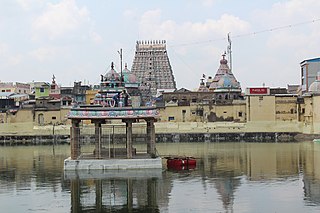
Adi Kumbeswarar Temple, Kumbakonam is a Hindu temple dedicated to Shiva, located in the town of Kumbakonam in Thanjavur District Tamil Nadu, India. Shiva is worshiped as Adi Kumbeswarar, and is represented by the lingam. His consort Parvati is depicted as Mangalambigai Amman. The presiding deity is revered in the 7th century Tamil Saiva canonical, greatest work, the Tevaram, written by Tamil saint poets known as the Nayanmars and classified as Paadal Petra Sthalam.

Thenupuriswarar Temple is a Hindu temple dedicated to the god Shiva located in the village of Patteeswaram, Tamil Nadu, India. Shiva is worshiped as Thenupuriswarar, and is represented by the lingam. His consort Parvati is depicted as Nyanambikai (Somakamalambigai). The presiding deity is revered in the 7th century Tamil Saiva canonical work, the Tevaram, written by Tamil saint poets known as the Nayanars and classified as Paadal Petra Sthalam. The temple is associated with the legend of Sambandar to whose view Nandi moved to have a direct view of the presiding deity. Muthupandal festival celebrated in the temple in associated with the legend.

Someswarar Temple is a Hindu temple dedicated to the deity Shiva, located in Kumbakonam, Tamil Nadu, India. Shiva is worshipped as Someswarar and is represented by the lingam. His consort Parvati is depicted as Somasundari. The presiding deity is revered in the 7th century Tamil Saiva canonical work, the Tevaram, written by Tamil saint poets known as the nayanars and classified as Paadal Petra Sthalam.
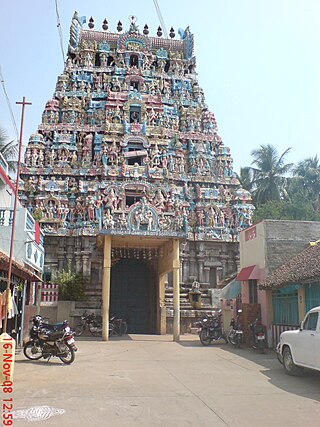
Kasi Viswanathar Temple, Kumbakonam is a Hindu temple dedicated to Lord Shiva, located in Kumbakonam, Tamil Nadu, India. Here, Lord Shiva is worshipped as Kasi Viswanathar, and His consort Parvati is depicted as Visalakshi. The presiding deity is revered in the 7th-century Tamil Saiva canonical work, the Tevaram, written by Tamil saint poets known as the nayanars and classified as Paadal Petra Sthalam.
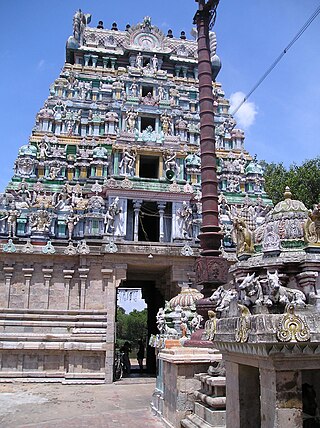
Kalyanasundaresar Temple, Nallur or Thirunallur is a Hindu temple dedicated to the deity Shiva in Nallur, Tamil Nadu, India. It is located 10 km (6.2 mi) away from Kumbakonam, 6 km (3.7 mi) east of Thirukkarugavur, and 30 km (19 mi) south of Thanjavur.

Pushpavananathar Temple is a Hindu temple dedicated to Shiva located in the village of Tiruppoonturutti near Tiruvaiyaru, Tamil Nadu, India. Shiva is worshiped as Aiyarappar, and is represented by the lingam and his consort Parvati is depicted as Soundaranayagi. The presiding deity is revered in the 7th century Tamil Saiva canonical work, the Tevaram, written by Tamil poet saints known as the nayanars and classified as Paadal Petra Sthalam.
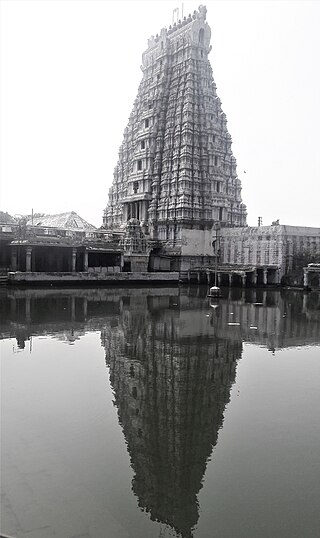
Madavar Vilagam Vaidyanathar temple is a Shiva temple located in Madavar Vilagam, located in one kilometer southerly to Srivilliputhur in Virudhunagar district in the South Indian state of Tamil Nadu, is dedicated to the Hindu god Shiva. Constructed in the Dravidian style of architecture, the temple has two precincts. Shiva is worshiped as Vaidyanathar and his consort Parvati as Sivakami. The temple is the largest Shiva temple in the district. Shiva is worshipped as Vaidyanathar or the "God of healing". The holy water of the Siddhamirtham tank in the temple complex is believed to have curative effects, and a holy dip here is believed to cure all diseases. The temple was built by Thirumalai Nayak during the 16th century.

Kailasanathar Temple in Srivaikuntam, a village in Thoothukudi district in the South Indian state of Tamil Nadu, is dedicated to the Hindu god Shiva. It is located 30 km from Tirunelveli. Constructed in the Dravidian style of architecture, the temple has three precincts. Shiva is worshipped as Kailasanathar and his consort Parvati as Sivakami. The temple is the sixth temple in the series of Nava Kailasams where the presiding deity of all the nine temples is Kailasanathar and associated with a planetary deity. The temple is associated with the planet Saturn.

Badrakali Amman Temple in Sivakasi, a town in Virudhunagar district in the South Indian state of Tamil Nadu, is dedicated to the Hindu god Badrakali. Constructed in the Dravidian style of architecture, the temple is believed to have been built during the 18th century with later expansion during the 19th and 20th centuries.

Othandeeswarar Temple in Thirumazhisai Chennai City in Tiruvallur district in the South Indian state of Tamil Nadu, is dedicated to the Hindu god Shiva. It is located 22 km from the state capital Chennai. Constructed in the Dravidian style of architecture, the temple was built during the 11th century by Chola king Kulothunga Chola II. Shiva is worshipped as Othandeeswarar and his consort Parvathi as Kulirvithanayaki.

Sathya Vageeswarar Temple in Kalakkad, a village in Tirunelveli district in the South Indian state of Tamil Nadu, is dedicated to the Hindu god Shiva. This Temple is Centered on Kalakad Town, It is located 45 km from Tirunelveli. Constructed in the Dravidian style of architecture, the temple has three precincts. Shiva is worshipped as Sathya Vageeswarar and his consort Parvathi as Gomathi.
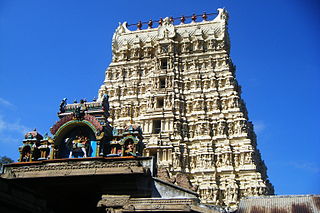
Papanasanathar Temple in Papanasam, a village in Tirunelveli district in the South Indian state of Tamil Nadu, is dedicated to Hindu god Shiva. It is located 60 km from Tirunelveli. Constructed in the Dravidian architecture, the temple has three precincts. Shiva is worshipped as Papanasanathar and his consort Parvathi as Ulagammai.

Balasubramaniyaswamy temple in Vennaimalai, a village in the outskirts of Karur in Karur district in the South Indian state of Tamil Nadu, is dedicated to the Hindu god Murugan. Constructed in the Dravidian style of architecture, the temple is located in the Karur - Pugalur Road. The legend of the temple is associated with Kamadhenu taking up the duties of Hindu god of creation Brahma and creating the hill of butter named Vennaimalai.

Kachabeswarar Temple, Thirukachur is a Hindu temple dedicated to the deity Shiva, located in Thirukachur, a village in Kanchipuram district in the South Indian state of Tamil Nadu. Shiva is worshipped as Kachabeswarar, and is represented by the lingam. His consort Parvati is depicted as Antanatchi and Kanniyumaiyal. The presiding deity is revered in the 7th-century CE Tamil Saiva canonical work, the Tevaram, written by Tamil saint poets known as the Nayanars and classified as Paadal Petra Sthalam. The temple is counted as a twin temple along with Marundeeswarar Temple located in the same village.

Kasi Viswanathar Temple in Tenkasi, a city in Tenkasi district in the South Indian state of Tamil Nadu, is dedicated to the Hindu god Shiva. Constructed in the Tamil style of architecture, the temple is believed to have been built by Pandyan ruler Parakrama Pandyan during the 13th century, with later additions from Madurai Nayaks. Shiva is worshipped as Kasi Viswanathar and his consort Parvathi as Ulagamman.

Narthana Vallabeswarar Temple is a Hindu temple dedicated to the deity Shiva, located in Thirukoodalaiyathoor, a village in Cuddalore district in the South Indian state of Tamil Nadu. Shiva is worshipped as Narthana Vallabeswarar, and is represented by the lingam. His consort Parvati is depicted as Gnanasakthi and Parasakthi. The presiding deity is revered in the seventh-century Tamil Saiva canonical work, the Tevaram, written by Tamil saint poets known as the Nayanars and classified as Paadal Petra Sthalam.
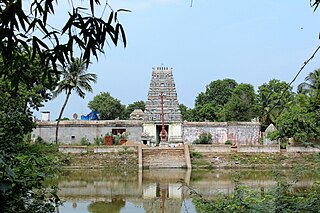
Thirukumaresar Temple is a Hindu temple dedicated to the deity Shiva, located in a ' RAJENDIRAPATTINAM ' also refer as 'YAZHPANAMPATTINAM' or ' ERUKATHAMPULIYUR ' is a village in Cuddalore district in the South Indian state of Tamil Nadu. Shiva is worshipped as Thirukumaresar, and is represented by the lingam. His consort Parvati is depicted as Verumulai Amman. The presiding deity is revered in the 7th century Tamil Saiva canonical work, the Tevaram, written by Tamil saint poets known as the Nayanars and classified as Paadal Petra Sthalam. The temple is also the birthplace of Saiva saint Tirunilakanta Nayanar

Vilwanatheswarar Temple, also spelled Bilvanathesvara temple, is a Hindu temple dedicated to the deity Shiva, located in Thiruvalam, a village in Vellore district in the South Indian state of Tamil Nadu. Shiva is worshipped as Vilwanatheswarar, and is represented by the lingam. His consort Parvati is depicted as Vallambigai. The presiding deity is revered in the 7th century Tamil Saiva canonical work, the Tevaram, written by Tamil saint poets known as the Nayanars and classified as Paadal Petra Sthalam.

